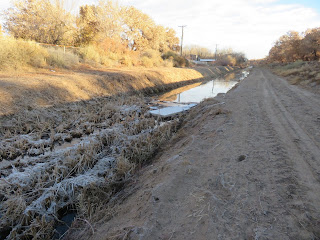“in order to make a man or boy covet a thing, it is only necessary to make the thing difficult to attain.” ―
This is a common earwig. The pincer found on the rear are a coupling device for males and not used to bite anything. They are not hunters, but eat...anything. It pays to be adaptable, especially around humans.
This trail is really only visible in early morning or evening as the long shadows from the sun show up the scratches of a beaver dragging twigs through the dust into a concrete lined ditch to begin the process of replacing a dam recently destroyed by humans. My money is on the beavers.
The river in Corrales is channelized and mostly narrow. Below the San Juan pumping station on Alameda the river is more spread out and resembles a wetlands. Seagulls recently stopped over here during a migration. There are patches of marshland all the way down the river to at least Bosque del Apache, 90 miles south.
The cause of the wetlands is this diversion dam. The plants growing in the shallows can be seen on the right. The rapid water rise can be seen on the left, where the taller plants have been recently submerged. This happened because the water can now be diverted due to increased releases from Cochiti Dam, many miles upstream. The natural river level has been raised by a foot. In flat land like this basin, that means a huge area of wetlands has been created almost overnight. The birds have noticed.
The narrow ditches in Corrales benefit strong vertical fliers like ducks, but do not work for the large winged geese, who prefer open spaces to feel safe. They are hard to see in this small picture, but there are large flocks of geese here.
Invasive Ravenna grass helps to trap sediment and stabilize soil. This is usually a bad thing for a river that likes to spread out, but in practice is more of a mixed bag for the shelter and micro-environments it creates. Below the Alameda road that divides Corrales bosque preserve from Rio Grande State park this tussock grass is taking over pretty large sections of the river, especially noticeable from the bridges over the river.
The Bosque is monitored by a pretty large organization. They produce good data about the changed affecting the river available to those who are interested in such things. Their activities do not get the notice it probably deserves, but then again most organizations in environmental science could claim the same thing.
This picture shows the reason why the ditches have to be constantly maintained. The right side shows a cleared ditch. The water is deeper and flows down the gradient of a slope On the left the reeds have trapped sediment and raised the overburden of soil, choking off the water flow and trapping construction trash like foam insulation. Heavy machinery to clean the ditch is only allowed to operate until April, which is bird nesting season. This limited window means work has to be identified and done very quickly, usually over a large area. This means an organization like MRGCD or the USACE has to be involved. These huge organizations often cannot be attentive to the special circumstances and concerns found at the local level, they will turn picturesque areas into generic construction sites overnight.
Here is a humble beaver dam achieving exactly the same thing as a mechanical digger; under budget, too. The work involved is actually pretty impressive and the structure gets pretty big if left alone.
The beaver itself is almost never seen, neither are the entire ecosystems of animals that benefit directly from the changes in the water level. Here, a raccoon (I think) has died. These large mammals often forage along the edges of beaver ponds in the summer, looking for crayfish. But they are very susceptible to avian influenza, which affects many birds too.
Heron prefer shallow, isolated pools of water to catch medium sized fish. They also use the large snags of dead cottonwoods to rest and watch for opportunities. They clearly prefer solitude, but habitiuate to noisy humans as the year continues.
Flickers prefer more dense vegetation and are hard to photograph, as they never hold still. This one was foraging and also chasing away a territorial rival, multitasking as usual. While related to woodpeckers, they have a much more generalist lifestyle and appetite.
The mallards are also impressively adaptable. They often migrate from the intense bread feeding ponds at Tingly to the more sedate ditches in Corrales for the evening, where they are more relaxed and pair bonded. Country life versus city commuting. The ones that roost in the city often prefer to spend the night in trees. probably to avoid city cats.
This Red tailed hawk seems pretty quiet. Not the fierce presence they usually project during the days of summer when they are protecting territory or nests. If their diet is mostly cottontails, then they are likely to not be hunting actively once the sun has risen. Being territorial, their density in any one place is very low, but they are very common and visible. One of the best benefits of Corrales is the bird watching and probably partly explains the high prices of the homes here. Of course, most people will complain about the lack of investment in infrastructure in the same breath. It's what we don't have that is the most keenly noticed. However, it pays to read Mark Twain and to look at what is actually out there for true satisfaction.















Seagulls? Really? That's amazing.
ReplyDeleteThey have had pelicans in the Sandias. Swans at Tingley ponds. Opossums in Corrales, all verified by someone taking a picture...
ReplyDeleteSaw a huge flock of what appeared to be seagulls this morning. Where would they be coming from? Going to?
ReplyDelete